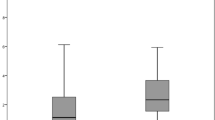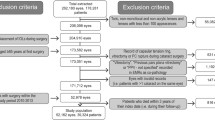Summary
The aim of this investigation was to ascertain the frequency of secondary cataract after implantation of PMMA or Silicone IOLs.
Patients and methods: In our series of patients we implanted 900 PMMA IOLs in a period of 4 years. In the following 3 years we implanted 1600 silicone IOLs. After the operation, a Nd: YAG laser capsulotomy was indicated there was a reduction in visual acuity and the patient asked for improvement. With the help of computer documentation we had the possibility to follow up a period of 6 years after PMMA and 3 years after silicone IOL implantation.
Results: (1) PMMA IOL: After implantation of PMMA IOLs we found a frequency of 22 % capsulotomies during the investigation period of 6 years; 4.9 % of them occurred during the 1st year and 8 % during the 2nd year. (2) Silicone IOL: During the control period of 3 years we found a capsulotomy rate of 9,9 %. Most happened in the 1st year.
Conclusions: Our 22.9 % capsulotomy rate after PMMA IOL implantation is lower than the rate mentioned in the literature. We noticed a peak of capsulotomies in the 2nd year after the operation. During a control period of only 3 years after implantation of silicone IOLs we found a capsulotomy rate of 9.9 %.
Zusammenfassung
Frage: Ziel unserer Untersuchung ist die Ermittelung der Nachstarhäufigkeit nach Implantation von PMMA- bzw. Silikonlinsen.
Patienten und Methode: Innerhalb von vier Jahren wurden 900 PMMA-IOL und innerhalb von drei Jahren 1600 Silikon-IOL von einem Operateur implantiert. Mittels computerunterstützter Dokumentation und Statistik aller Operationen konnten wir eine Nachbeobachtung von sechs Jahren für PMMA- und von bis zu drei Jahren für Silikon-IOL durchführen.
Ergebnisse: PMMA-IOL: Die Gesamtkapsulotomie-Rate liegt innerhalb einer Gesamtbeobachtungszeit von sechs Jahren bei 22,9 %, wovon 4,9 % innerhalb des ersten Jahres gelasert wurden. Silikon-IOL: Bei den Silikon-IOL beträgt die Kapsulotomierate innerhalb einer Gesamtbeobachtungszeit von drei Jahren 9,9 %, wovon sich der größte Anteil mit 5 % innerhalb des ersten Jahres entwickelte.
Schlußfolgerungen: Unsere Daten deuten darauf hin, daß die Häufigkeit eines visusmindernden Nachstars bei Silikon-IOL geringer ist als bei PMMA-Linsen. Eine visusrelevante Nachstarbildung tritt nach Silikon-IOL-Implantation früher auf und ist in den ersten zwei postoperativen Jahren nahezu abgeschlossen, während sie nach PMMA-Implantation protrahierter bis zum 6. postoperativen Jahr erfolgt.
Similar content being viewed by others
Author information
Authors and Affiliations
Rights and permissions
About this article
Cite this article
Pradella, S., Täumer, R. Frequency of Nd: YAG capsulotomy after implantation of intraocular lenses out of PMMA and silicone. Ophthalmologe 95, 482–485 (1998). https://doi.org/10.1007/s003470050301
Published:
Issue Date:
DOI: https://doi.org/10.1007/s003470050301




